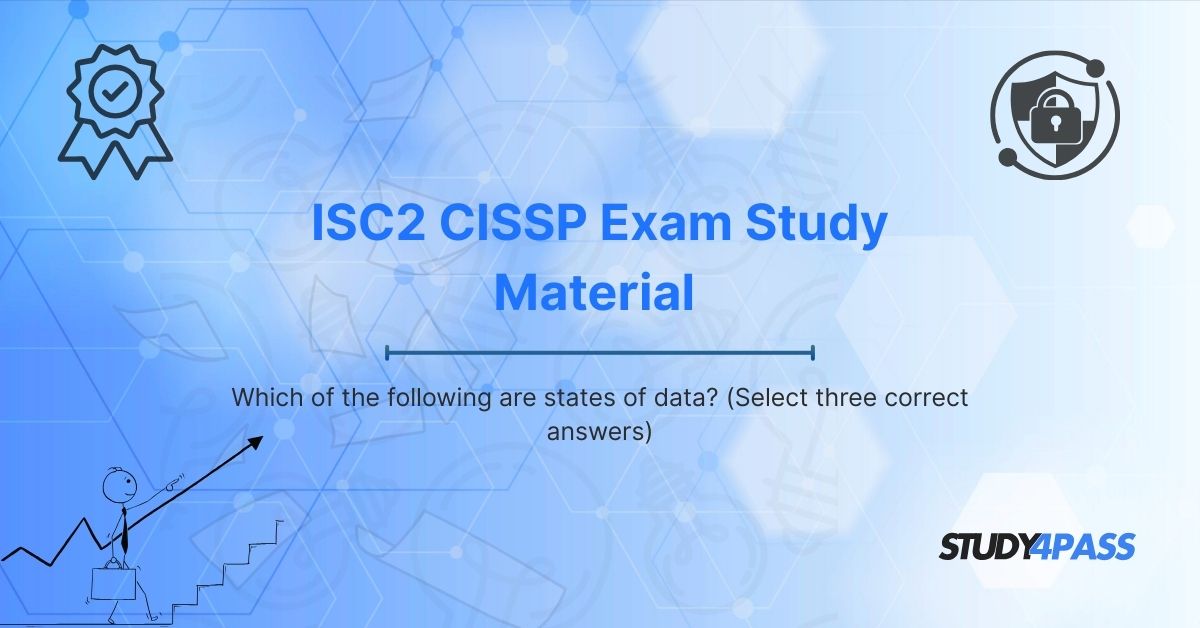Introduction
The Certified Information Systems Security Professional (CISSP) certification, offered by (ISC)², is one of the most prestigious credentials in the field of information security. A crucial topic in the CISSP study material is understanding the states of data, which plays a significant role in data security and risk management.
In this article, we will explore:
- The three primary states of data
- Why this concept is essential for the CISSP exam
- How Study4Pass can help you master CISSP topics efficiently
By the end of this guide, you will have a clear understanding of data states and how they apply to real-world cybersecurity scenarios.
What Are the States of Data?
Data exists in different states, and each state requires specific security controls. According to (ISC)² CISSP study material, the three primary states of data are:
- Data at Rest
- Data in Transit (Data in Motion)
- Data in Use
Let’s break down each of these states in detail.
1. Data at Rest
Definition:
Data at rest refers to inactive data stored physically or digitally, such as files on a hard drive, databases, or archived records.
Examples:
- Files stored on a hard disk
- Database records
- Backup tapes and cloud storage
Security Concerns:
- Unauthorized access (e.g., theft of hard drives)
- Data breaches (e.g., exposed databases)
- Malware attacks (e.g., ransomware encrypting stored files)
Security Controls:
- Encryption (AES, RSA)
- Access controls (RBAC, MAC)
- Data masking & tokenization
CISSP Relevance:
Understanding how to protect data at rest is crucial for domains like Security Architecture and Engineering (Domain 3) and Asset Security (Domain 2).
Data in Transit (Data in Motion)
Definition:
Data in transit refers to data actively moving between systems, such as emails, network transfers, or API calls.
Examples:
- Web traffic (HTTPS)
- Email communications (SMTP, IMAP)
- VPN connections
Security Concerns:
- Man-in-the-middle (MITM) attacks
- Eavesdropping (packet sniffing)
- Session hijacking
Security Controls:
- Transport Layer Security (TLS/SSL)
- Secure File Transfer Protocols (SFTP, SCP)
- IPSec for VPNs
CISSP Relevance:
This topic is essential for Communication and Network Security (Domain 4) in the CISSP exam.
Data in Use
Definition:
Data in use refers to data actively being processed by a system or user, such as data loaded into RAM or being edited.
Examples:
- A file opened in an application
- Data processed by a CPU
- Temporary files in memory
Security Concerns:
- Memory scraping attacks
- Unauthorized process access
- Side-channel attacks
Security Controls:
- Memory encryption
- Process isolation
- Secure coding practices
CISSP Relevance:
This falls under Security Operations (Domain 7) and Software Development Security (Domain 8).
Why Is This Important for the CISSP Exam?
The (ISC)² CISSP exam tests your ability to apply security principles across different scenarios. Knowing the three states of data helps in:
- Selecting appropriate security controls
- Understanding data lifecycle management
- Answering scenario-based questions accurately
How Study4Pass Helps You Master CISSP Concepts?
Preparing for the CISSP Exam requires structured learning and high-quality study materials. Study4Pass offers:
- Comprehensive CISSP Study Guides – Covering all 8 domains with real-world examples.
- Practice Exams – Simulating the actual CISSP test environment.
- Flashcards & Cheat Sheets – Quick revision for key concepts like data states.
- Expert-Led Training – In-depth explanations for complex topics.
By using Study4Pass, you can save time, avoid information overload, and focus on high-yield exam topics such as data states ensuring you pass the CISSP on your first attempt.
Conclusion
Understanding the three states of data (at rest, in transit, and in use) is fundamental for the CISSP exam and real-world cybersecurity practices. Each state requires unique security measures, and mastering these concepts will help you excel in both the exam and your career.
For the best CISSP study material, visit Study4Pass and take your preparation to the next level!
Special Discount: Offer Valid For Limited Time “ISC2 CISSP Study Material”
Actual Exam Questions For ISC2's CISSP Test Prep
Sample Questions For ISC2 CISSP Learning Path
1. Which of the following are states of data? (Select three correct answers)
A) Data in use
B) Data in transit
C) Data at rest
D) Data in cloud
E) Data in memory
2. Which three of the following represent the primary states of data?
A) Data in motion
B) Data in storage
C) Data in processing
D) Data in backup
E) Data in archive
3. Identify three correct states of data from the options below:
A) Data in use
B) Data in cache
C) Data being transmitted
D) Data stored offline
E) Data in RAM
4. Which of the following are recognized states of data in cybersecurity? (Choose three)
A) Data in execution
B) Data in transit
C) Data at rest
D) Data in buffer
E) Data in queue
5. Select three correct states of data as per data security standards:
A) Data in processing
B) Data in network
C) Data in storage
D) Data in logs
E) Data in temporary files


